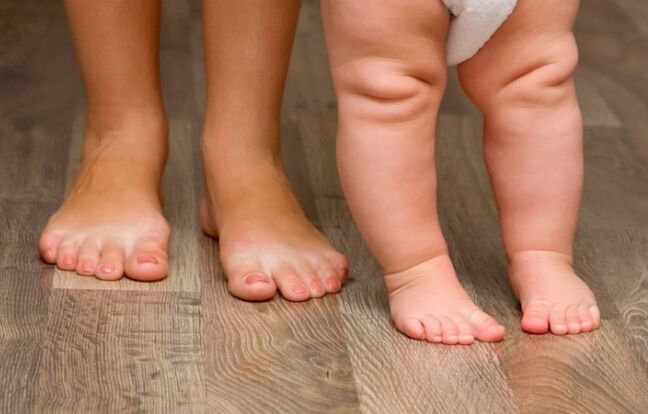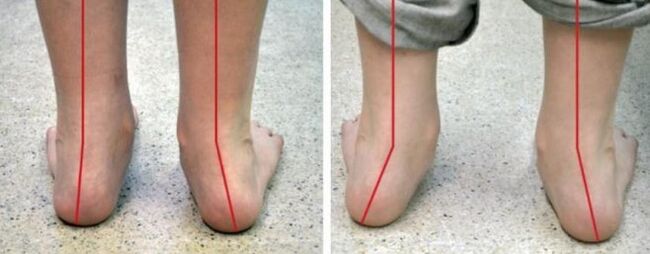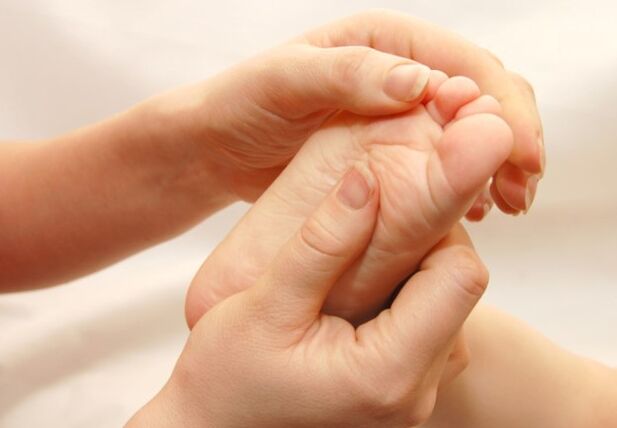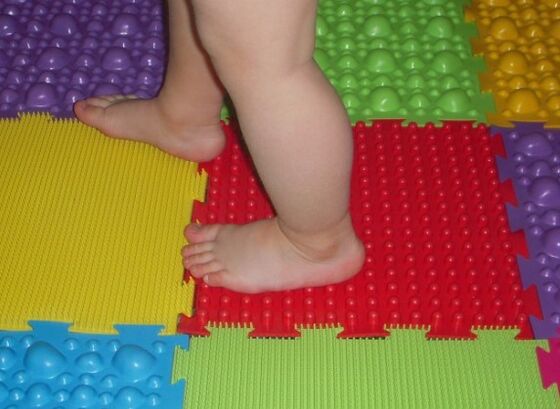The deformation valgus of the foot in children occurs quite often in orthopedic practice - there are 100 healthy children with different degrees of flat feet per 100 healthy.This diagnosis should not be afraid, you must understand the problem and start solving it under the direction of an experienced specialist.In most cases, the curvature of the feet is treated at home using exercise therapy, massage and other auxiliary methods, and it is only an advanced stage that the surgical intervention is required.

What is the valgus and flat deformation?
The valgus foot is a change in the axes of the lower limbs, in which the foot floods inside, and the heel region and the fingers are protruding outwards.With a timely diagnosis and the implementation of all the doctor's recommendations, the defect is adjusted and the correct foot is formed.The absence of treatment leads to a deformation with flat valgus of the foot and to a lifelong change in the functioning of the musculoskeletal system.
Signs and symptoms of deformation valgus in a child
Deformation of the foot in children is diagnosed by 1-1.5 years, when the baby begins to walk alone.In case of congenital pathology, the orthopedist will notice the deviation of the standard at 2-3 months of the baby's life.
Parents can recognize the start of the disease themselves, noting that the child is incorrectly walking on the leg, moving the center of gravity inside.The approach can be awkward, kosolapih, pronounced flat feet are observed.If you put the child directly and gather your knees, a distance of 4 to 5 centimeters forms between the feet.With the development of the deformation on both sides, the legs acquire the contours of the letter "X".There is a comparison of this pathology with "knees of kiss" (see photo).
The incorrect distribution of loads leads to the rapid fatigue of the child, it often prefers passive games, avoids physical activity.Older children often complain about pain in the bottom of the leg, joints and spine, in the evening, swelling of the feet may appear.Little by little, the fingers and heels are deformed and go away, the skin on the feet thickened, the corns appear.The shoes of a child with such deformation of the foot are torn unevenly - the interior of the sole is erased more quickly.
Anatomical and functional flat feet and their causes
All newborns have anatomical flat feet, because muscles, ligaments and tendons are constantly relaxed.When the child begins to get up and tries to walk, the ligament apparatus is reinforced and the right arch of the foot forms.If this does not happen, orthopedists talk about the development of functional flat feet.
The reasons for the development of flat feet in young children:
- The consequences of a lack of calcium and other trace elements during pregnancy.A woman must follow all the doctor's recommendations, join a healthy and eat well lifestyle.
- Genetic factor.Pathology can be inherited, so if the flat feet are present in parents, attention must be paid to the prevention of the foot deformation in children.
- Transferred to richitism.One of the causes of the pathological formation of the foot is the lack of vitamin D. The bones are softened, the musculoskeletal system is curved and the entire foot is flattened.
- Early definition on the legs.Although the baby can like to count on the legs, do not let him do it earlier than 7 to 8 months.
- The shoes wrongly incorrectly selected are too free or cramped, on flat soles.Do not buy shoes for the child "for growth" (the offer is allowed to be a maximum of size), because the foot will be in a free position.Walk barefoot on a flat surface (house on the floor).
- The following illnesses can cause a squamous installation of the feet: cerebral paralysis, polio, obesity, congenital dislocation of the thigh.Various wounds in feet, long -term stay in gypsum.

The degree of development of pathology
There are four degrees of development of a scary curiosity:
- The first degree - The baby turns feet no more than 15 degrees.This is the initial deformation stage, with a serious approach to the treatment of the valgus, it can be well corrected and the foot is completely straightened.
- The second step is characterized by a deviation of the 15-20 degree foot.For treatment, you will need a little more time and effort.
- With the third degree, the gap is 20 to 30 degrees.Prolonged treatment is necessary (the use of orthopedic shoes, massage, exercise therapy, physiotherapy).
- The fourth is the most difficult curvature of feet over 30 degrees.In the absence of the effect of a complex treatment, a surgical correction of the lower limbs is carried out.
Treatment methods
To obtain a persistent positive result, you should pay attention to the treatment.It must be complex and long, after the appearance of the first results, in no case should you stop treating the baby.The normal approach and health of the child depends on the efforts and perseverance of parents.You will find below the main types of deformation of the Valgus deformation of the lower limbs.
Pharmacotherapy
Medical drugs for X -shaped curvature of the lower limbs are used to relieve the inflammation and the pain of the joints, but it is impossible to get rid of the disease than to drug treatment.Usually, a specialist prescribes intra-articular drug administration.
Orthopedic treatment with the use of devices and the choice of shoes for children
As prescribed by a doctor, to treat the curvature of the feet, it is possible to use special orthopedic devices - various fixers, bandages and tires.A prerequisite for a persistent positive result is to wear orthopedic shoes.

When you choose such shoes, you need to pay attention to the following points:
- Shoes must be made of natural and respiratory materials;
- The child must feel comfortable in her, should not crush or rub him anywhere;
- It is necessary to have a hard and high ass so that the ankle articulation and the heel are recorded in the right position;
- the presence of fixings that regulate the shoes in the width of the foot;
- The presence of a small wide heel, ideally - "Thomas heel" (inside the foot, it is slightly longer than outside).
Medical physical education and exercises for daily execution at home
The exercises must be carried out daily, here are some:
- Alternate walking on socks and walking on the heels (first with raised, then the toes in hand) for 5 minutes;
- Sitting on the floor with tense legs to tighten and untangle the toes;
- You can offer the child to try to raise various small objects on the floor;
- Walking on an unequal surface, for example, can be brought home with river stones or buy a massage mat;
- Walk on the outer edge of the foot;
- Know a wooden roll or a small ball;
- Rotation by feet from left to right and vice versa.
Massage and physiotherapy
The massage is done at home, lessons for 2-3 weeks, then a break.This will help strengthen muscles and relieve them of stress, special skills are not necessary for this.Total massage time is 20 to 30 minutes.You should start with a general massage - the child in a bed on the stomach, the hands are extended along the body, the head is turned to the side.Hand movements should not cause baby pain:
- It is easy to caress the palms along the back, gradually increasing with pressing;
- Type the witches with the edge of the palm, slightly pinch;
- Sort the folds of the skin in the direction of the lower back to the shoulders;
- Finish the rear massage while caressing;
- Caress the legs of the heels with buttocks and back, it is easy to pinch;
- Mark the femoral legs and muscles;
- Finish caressing your legs.
- Rub the feet with the edge of the palm, gradually increasing pressures;
- The thumb of the hand "draw" the number 7 on the sole;
- With one hand, hold the leg by the heel, the second - rub the ankle joint;
- It is easy to pull the leg by the fingers "on yourself".

If necessary, the doctor can prescribe physiotherapy, for example: magnetotherapy, acupuncture, electrophoresis, paraffin wraps.This will improve metabolism in the problematic area and will help obtain complete absorption of drugs.
Surgery
In exceptional cases, when complex therapy does not give a result, parents are invited to solve the problem surgically.The modern methods used in surgery allow you to do without metallic structures and wear gypsum.The doctor corrects the direction of the ligaments and levels the angle of location of the feet.After the correction, the recovery period and the compulsory wearing of orthopedic shoes follow.
Is it possible to completely cure the deformation?
With an appropriate call to a specialist and a serious approach to treatment, it is quite possible to straighten out scorching.At the same time, the treatment should be started up to the age of two, then at school, you can completely get rid of the curvature of the feet.In children over 2 years old and with advanced deformation of the lower limbs, it is quite difficult to cure the disease until the end, but you can improve the situation a lot.
What can be the consequences if you don't treat curvature?
Squameful feet in children will not be corrected by themselves, so that the symptoms of the pathology cannot be ignored.Such a gap of the feet leads to a change throughout the musculoskeletal system.Due to the unequal load distributed, there are problems with the knee and coxofemoral joints, as well as with the spine.In children, not only was the approach moved, but also becoming an impossible physical activity (running, active games), as this causes pain and inflammation in the joints.
- From the newborn period, it is necessary to observe the development of the baby's legs, to inspect them for injuries, to make an easy massage and gymnastics.As a timely manner to undergo preventive examinations to the orthopedist and in his absence - to the surgeon.
- You shouldn't put the baby too early on the legs - for the fragile muscles of the legs and joints, it is a huge load.When he feels strength, he will try to get up, joining support.For the same reason, the use of walkers and riders is undesirable, at least up to eight months.
- Particular attention must be paid to the approach - it must be correct and correspond to age.In any doubt, you should consult a specialist.
- Children's shoes must be of high quality, with a small heel and an orthopedic insole (we recommend reading: interior soles for children with flat feet).From seven months, when the child begins to stand on his legs, it is recommended to wear light sandals with a hard back, so that the foot will be fixed in the right position, the load on the muscles and the joints will be distributed evenly.If there is a deformation of the stop of 1 to 2 degrees, it is advisable to buy orthopedic shoes in specialized stores and pharmacies.
- Prevention of richitism.The child should spend enough time in the street, because vitamin D is formed in the skin under the influence of the sun.For prevention, you can give the child vitamin D to the dosage prescribed by a doctor.It is necessary to provide a complete and balanced diet.
- In summer, it is useful to give the child to run barefoot, the small pebbles have a massage effect.At home, use a massage mat with various irregularities daily for several minutes.
- The exercise strengthens the musculoskeletal system and prevents the development of flat feet.If possible, you can save a child for swimming or in the sports section (we recommend that you read: How to swim for newborns in the bathroom or the swimming pool?).
























